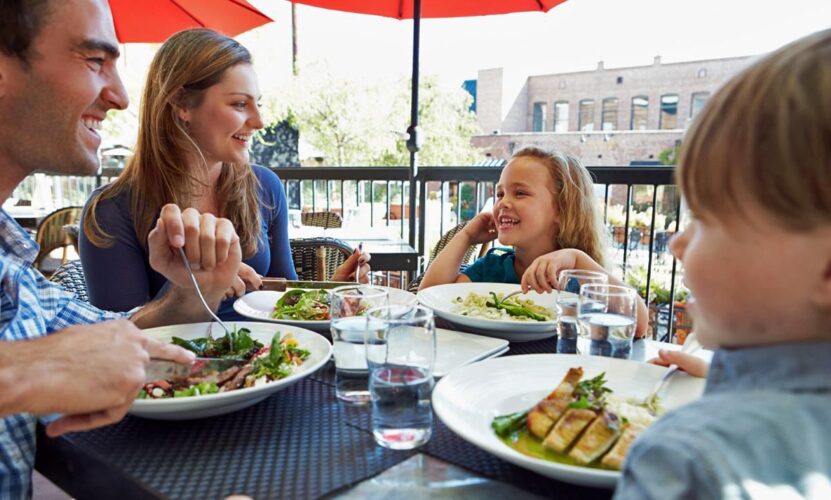GET OUT THERE: Kids menus: A well‑intentioned but bad idea

Restaurants are now offering healthier food options for kids to keep them interested in their food.
Picture this. It’s the Roaring ’20s, Prohibition is in full swing, and restaurants are scrambling. They lost booze revenue, and suddenly a bright idea emerges: “Kids menus.” Cue the crayons, nursery�’rhyme headings, and pint�’sized, bland plates to bring in families.
Over the past century, however, what sounded like a good idea has devolved into a dubious excuse to feed our children less nutritious, more waterdowned, and pacifying, if not lazy, comfort food.
Culinary historian Adrienne Bitar of Cornell explains to me that as yesteryear’s saloon-turned-restaurants needed new patrons, they rebranded with a family-friendly turn. Yes, the kids menu was less about culinary innovation and more about marketing survival.
By the late 1950s and ’60s, family-friendly restaurant chains featured illustrated kids’ menus with dishes like “Jack Horner” PB&J, “Tommy Tucker” turkey and gravy, and “Happy Clown” spaghetti — each paired with Jello or ice cream. These playful menus often doubled as games or coloring pages and solidified kids as a powerful marketing demographic when it came to capturing the hearts and wallets of income-earning Americans.
By the 1970s, fast-food giants took kids menus to the next level. Burger Chef launched the “Funmeal” in 1973, followed by the McDonald’s Happy Meal in 1978, replete with included toys to induce collective loyalty. At first, kids’ menus served nutrition-first intentions, Bitner says. Pieces of lamb chops, creamed chicken, mashed potatoes — simple, unseasoned, affordable.
Today, however, you can expect lots of deep-fried chicken fingers, indulgent mac & cheese, limp pizza on a bready crust, and supersized fries. Bitar laments that far more health could be packed into smaller portions of normal menu fare, but instead restaurants opt for “highly�’processed, bland, high�’calorie meals to boost their profits.”
In addition to lacking nutrition, UNLV’s Elizabeth Nelson notes another downside to kids menus: “Limiting children to narrow palettes means missed moments of discovery.” On the contrary, she recalls her five-year-old son delightfully eating beet�’and�’goat�’cheese salad for lunch — much to the server’s surprise. Her kids now eat anything, she says. But reliance on kids’ menus leaves most kids unprepared for broader food experiences, especially when it comes to “eating our veggies.”
Of course, kids menus serve a clear business purpose. They bring families in, keep prices low, boost loyalty, and increase profits.
But change is happening. Both Bitar and Nelson have noticed that today’s parents increasingly want their kids to eat the same way — or at least the same flavors — as adults. That means bypassing kids’ menus and ordering smaller or shared portions from the “adult” menu to expose their children to better ingredients, food combinations, and overall health. And parents are doing this both at home and while eating out.
Bitar calls this approach the ultimate food education: flavor exploration, nutritional literacy, and no marketing gauntlet. “Eating out should be a treat, not a daily diet,” Nelson says. “A better approach is to teach kids something that lasts through rotating tastes, not just nostalgia dishes.”
As a father of five, I get it. Encouraging kids to eat their dinner can be a pain. Like iPad babysitting, ordering from the kids menu is definitely the path of least resistance. But like Nelson, my wife and I have tried, fought for, and mostly succeeded in exposing our children to a wide range of foods and pallets that, as predicted, has contributed to their adventurous spirit. Like parenting, I believe the effort is worth it.
If you feel the same, Bitar suggests letting infants explore grown-up tastes early on, instead of relying on what’s branded for them. Like the French have found since they invented modern cooking, if you raise a child on what grown-ups eat, they’ll eat almost anything at a young age and continue exploring as they mature.
By all means, eating out should be fun and inclusive. And there’s no shame in eating junk food once in a while. But that doesn’t mean our families need two separate menus when dining together.
After all, food has and should always be a shared experience. Maybe, just maybe, persuading kids to savor real, grown-up food may do more for them than any toy�’focused Happy Meal ever could.
Blake Snow contributes to fancy publications and Fortune 500 companies as a bodacious writer-for-hire and seasoned travel journalist to all seven continents. He lives in Provo, Utah with his wife, five children, and one ferocious chihuahua.

